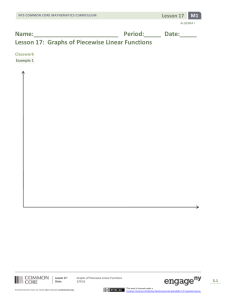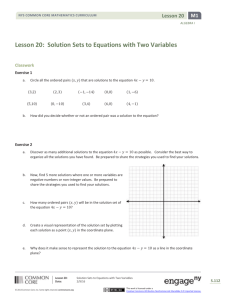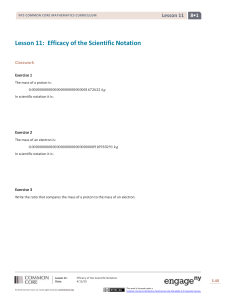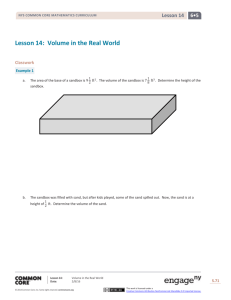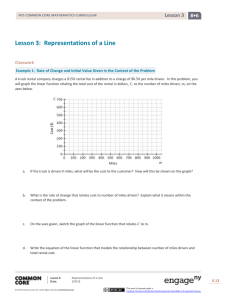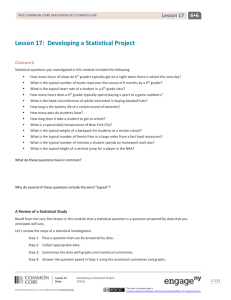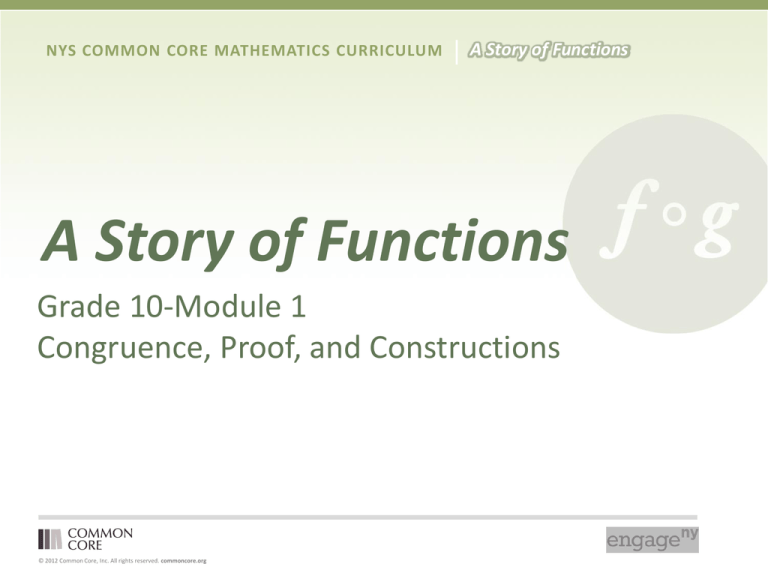
NYS COMMON CORE MATHEMATICS CURRICULUM
A Story of Functions
A Story of Functions
Grade 10-Module 1
Congruence, Proof, and Constructions
© 2012 Common Core, Inc. All rights reserved. commoncore.org
NYS COMMON CORE MATHEMATICS CURRICULUM
A Story of Functions
Session Objectives
• Articulate and model the instructional approaches to teaching the content
of the first half of the lessons.
• Examine how the topics and lessons promote mastery of the focus
standards and address the major work of the grade.
• Articulate connections from the content of previous grade levels to the
content of this module.
© 2012 Common Core, Inc. All rights reserved. commoncore.org
NYS COMMON CORE MATHEMATICS CURRICULUM
A Story of Functions
Participant Poll
•
•
•
•
•
Classroom teacher
School leader (Math AP, Department Chair, etc.)
Principal
District leader
BOCES representative
© 2012 Common Core, Inc. All rights reserved. commoncore.org
NYS COMMON CORE MATHEMATICS CURRICULUM
Agenda
1. Module 1 Overview
a. Driving concepts
2. Constructions
a. Basic compass work
b. Lesson 1
3.
4.
5.
6.
Expert Lesson Group Work
Expert Lesson Presentations
Group Walk Activity
Summary of Work & Closure
© 2012 Common Core, Inc. All rights reserved. commoncore.org
A Story of Functions
A Story of Functions
NYS COMMON CORE MATHEMATICS CURRICULUM
!
!
!
!
NYS"COMMON"CORE"MATHEMATICS"CURRICULUM"
A"Story"of"Functions"Curriculum"Overview"" !
!!
Module 1: Congruence, Proof and Constructions
! " # # " $ %! " &' %! ( &&)! ( *( # %# +, - %)$ %# +. / ' # +. )! - %%0%%! "#$%&' "%(") *+, $-%+. %! 122341516 %# 78%9: 2%; 27<=>%?@
AB
Curriculum"Map"
@#2%
! "#$%&' &((&) *+%, "#&-
' : 9: . 4
BD%<7N>
. /: . /: . 4
BD%<7N>
. . : =: . 4
BD%<7N>
. 4: . . : . 4
BD%<7N>
! "#$%&. /&((&! %01 %2"3
! "#$%&. . &((&) *+%, "#&--
- J7J=%'L76 3E7J3: E>
. : . >: . ;
- J7J=%'L76 3E7J3: E>
- J7J=%'L76 3E7J3: E>
BD%<7N>
; : 44: . ;
# QS%%'LJ=E<3EH%J: %.I 2==%
T 36 =E>3: E>%UAD%<7N>V%%%
# RS
' L82=>>3: E>%7E<%'\ 17J3: E> # RS%%! : EE=4J3EH%+5H=M27%7E<%
UQD%<7N>V%%%%
; =: 6 =J2N%JI 2: 1HI %
! : : 2<3E7J=>%UBW%<7N>V%%%%%
BD%<7N>
# WS
[ 17<27J34%X1E4J3: E>
UQD%<7N>V
?: 4' : . ;
BD%<7N>
# WS
! 3245=>%Z 3JI %7E<%] 3JI : 1J%
! : : 2<3E7J=>
UBW%<7N>V
- J7J=%'L76 3E7J3: E>
# QS
BD%<7N>
&7J3: E75%7E<%'L8: E=EJ375%
%%%%%%%%%%%%%%%%%%%%%%%%%%%%%%%%%%%%%%%%%% X1E4J3: E>
UBW%<7N>V%%%%%%%%%%%%%%%%%%%%%%%%%%%%%%%%%%%%%
BD%<7N>
4: . <: . ;
! "#$%&.4&((&5"%6#*67*78
# AS
&=57J3: E>I 38>%Y=JZ ==E%
BD%<7N>
# AS
# AS
# AS
[ 17EJ3J3=>%7E<%&=7>: E3EH%
! : 6 85=L%$ 16 M=2>%7E<%
! : EH21=E4=G%,2: : 9G%7E<%
, : 5NE: 6 375G%&7J3: E75G%7E<%
Z 3JI %'\ 17J3: E>
. 27E>9: 26 7J3: E>
!%%%
:%%
E>J214J3
: E>
&7<3475%&=57J3: E>I 38>
UQD%<7N>V%%%%%%%%%%%%%%%%%%%%%%%%%%%%%%%%%%
%%%
URD%<7N>V%%%%%%%%%%%%%%%%%%%%%%%%%
%%%%%
%%%%%%%%%%%%%%%%%%%%%%%%%%%%%%
BD%
<7N>
URW%<7N>V%%%%%%%%%%%%%%%%%%%%%%%%%%%%%%%%%%%%%%%
U%
RW
%%%<7N>V%%%%%%%%%%%%%%%%%%%%%%%%%%%%%%%%%%%%%%%%%%%%%%%%%%%%%%%%%%%%
# BS%T =>4238J3K=%-J7J3>J34>
UBD%<7N>V%%%%%%%%%%%%%%%%%%%%%%%%%%%%%%%%%%%%%%%%%%%%%%%%%%%%%%%%%%%%
# BS
BD%<7N>
# BS
# BS
. 23H: E: 6 =J234%X1E4J3: E>
# QS
- 36 35723JNG%,2: : 9G%7E<
^=4J: 2>%7E<%# 7J234=>
UBD%<7N>V
*3E=72%7E<%'L8: E=EJ375%
. 23H: E: 6 =J2N
URD%<7N>V%
&=57J3: E>I 38>
# QS%X1E4J3: E>
BD%<7N>
URW%<7N>V
URD%<7N>V%%%%%%%%%%%%%%%%%%%%%%%%%%%%%%%%%%%%%%%%%%%%%%%%%%%%%%%%%%%%%%%%%%%%%%%
URW%<7N>V%%%%
BD%<7N>
# RS%.23H: E: 6 =J2N
UAW%<7N>V%
# RS
)E9=2=E4=>%7E<%! : E451>3: E>%
92: 6 %T 7J7
URD%<7N>V%
# WS
, 2: M7M353JN%7E<%-J7J3>J34>
UQD%<7N>V
BD%<7N>
BD%<7N>
<: 4=: . ;
BD%<7N>
9: 49: . ;
&=K3=Z %7E<%'L76 3E7J3: E>
&=K3=Z %7E<%'L76 3E7J3: E>
&=K3=Z %7E<%'L76 3E7J3: E>
&=K3=Z %7E<%'L76 3E7J3: E>
"
$ : J=%JI 7J%<7J=%7882: L36 7J3: E>%72=%M7>=<%: E%7%932>J%>J1<=EJ%<7N%: 9%?OPOAB%7E<%57>J%<7N%: 9%POBPOAQF
! "#$
!
! " # $%&'( ) *'
3 %0# %,&.
+ " ( ) ,-,. '
( ) *'/ 0*%1-) 2
( ) *'/ 0*%1-) 2
412%$&( '( ) *
/ 0*%1-) 2
BD%<7N>
5,( ,-6,-76'( ) *'
9" ) 7,-0) 6
8&0$( $-1-,.
( ) *'/ 0*%1-) 2
( ) *'/ 0*%1-) 2
%
C BDAB%! : 6 6 : E%! : 2=%)E4FG%+55%23HI J>%2=>=2K=<
A"Story"of"Functions:""A"Curriculum"Overview"for"Grades"9512!
Date:"
1/30/13!
© 2012 Common Core, Inc. All rights reserved. commoncore.org
©!2012!Common!Core,!Inc.!All!rights!reserved.!commoncore.org!
4"
NYS COMMON CORE MATHEMATICS CURRICULUM
A Story of Functions
Icebreaker!
• Each table needs a poster paper and no more than two markers.
• A vocabulary word will be given. Once you see/hear it, write down as many
words as possible related to the vocabulary word.
• The table with the most words wins!
• You have 2 minutes to work.
• Anyone can write, but only with the two markers provided.
• Ready, Set, Go!
ANGLES
© 2012 Common Core, Inc. All rights reserved. commoncore.org
NYS COMMON CORE MATHEMATICS CURRICULUM
Module 1 Overview
•
•
•
•
•
Topics A-C and Lesson Titles
Focus Standards
Foundational Standards
Mathematical Practice Standards
New and Familiar Terms
© 2012 Common Core, Inc. All rights reserved. commoncore.org
A Story of Functions
NYS COMMON CORE MATHEMATICS CURRICULUM
A Story of Functions
Driving Concepts
1.
The module culminates in the concept of congruence and its application in
proof problems.
a. Two figure are congruent if there exists a finite composition of basic rigid motions
(rotations, reflections, translations) that maps one figure onto the other figure.
2.
Discussion of congruence requires an understanding of rigid motions
3.
Proof problems require geometric justification (practiced through
Unknown Angles) and an application of transformations
4.
Transformations are inherently linked to constructions, i.e., the concept of
a perpendicular bisector is essential to reflections
© 2012 Common Core, Inc. All rights reserved. commoncore.org
NYS COMMON CORE MATHEMATICS CURRICULUM
A Story of Functions
Working with Compasses
What to expect when working with compasses:
1.
What kind of experience do students have with compasses?
2.
What kinds of difficulties should we anticipate from students?
3.
What problems should we anticipate regarding the materials themselves?
© 2012 Common Core, Inc. All rights reserved. commoncore.org
NYS COMMON CORE MATHEMATICS CURRICULUM
Construction Essentials
Studying constructions requires:
1.
Ability to use a compass
2.
An understanding of the importance of labeling
3.
How to follow and write instructions
© 2012 Common Core, Inc. All rights reserved. commoncore.org
A Story of Functions
NYS COMMON CORE MATHEMATICS CURRICULUM
A Story of Functions
Activity 1
Construct 3 circles of different sizes.
1. Use geometric vocabulary to describe what circles of “different sizes” mean?
© 2012 Common Core, Inc. All rights reserved. commoncore.org
NYS COMMON CORE MATHEMATICS CURRICULUM
A Story of Functions
Activity 2
Construct the figure described in the steps below. Compare your construction
to that of a neighbor.
1.
2.
3.
4.
5.
6.
Draw circle K.
Label the endpoints of the diameter of circle K as A and B.
Draw circle A with radius AK.
Label endpoints of the diameter of circle A as KL.
Draw circle B with radius BK.
Label endpoints of the diameter of circle B as KM.
If LA = x, what expression represents AM?
© 2012 Common Core, Inc. All rights reserved. commoncore.org
A Story of Functions
NYS COMMON CORE MATHEMATICS CURRICULUM
Activity 2 Construction
1.
Share out any interesting observations
you notice about the figure.
L
A
2.
Can we do this problem WITHOUT
labels?
3.
What difficulties might students face with this problem?
K
B
4. Consider this problem: imagine the same figure with no labels. Write
the steps to perform the construction. How would students manage this
task?
© 2012 Common Core, Inc. All rights reserved. commoncore.org
M
NYS COMMON CORE MATHEMATICS CURRICULUM
A Story of Functions
Constructions and Mathematics Practices
Which Mathematical Practices are inherent to the successful completion of
Topic A?
MP 5 – Use appropriate tools strategically
MP 6 – Attend to precision
MP 7 – Look for and make use of structure
© 2012 Common Core, Inc. All rights reserved. commoncore.org
NYS COMMON CORE MATHEMATICS CURRICULUM
A Story of Functions
Lesson 1
Opening Exercise
Joe and Marty are in the park playing catch. Tony joins
them, and the boys want to stand so that the distance
between any two of them is the same. Where do they
stand?
How do they figure this out precisely? What tool or
tools could they use?
© 2012 Common Core, Inc. All rights reserved. commoncore.org
NYS COMMON CORE MATHEMATICS CURRICULUM
A Story of Functions
Lesson 1
Vocabulary
1
The _______ between points and is the set consisting of
, , and all points on the line between and .
2
A segment from the center of a circle to a point on the
circle.
3
© 2012 Common Core, Inc. All rights reserved. commoncore.org
Given a point in the plane and a number , the _______
with center and radius is the set of all points in the
plane that are distance from the point .
NYS COMMON CORE MATHEMATICS CURRICULUM
Lesson 1
Example 1
© 2012 Common Core, Inc. All rights reserved. commoncore.org
A Story of Functions
NYS COMMON CORE MATHEMATICS CURRICULUM
Lesson 1
© 2012 Common Core, Inc. All rights reserved. commoncore.org
A Story of Functions
NYS COMMON CORE MATHEMATICS CURRICULUM
Lesson 1
Example 2
© 2012 Common Core, Inc. All rights reserved. commoncore.org
A Story of Functions
NYS COMMON CORE MATHEMATICS CURRICULUM
Lesson 1
Geometry Assumptions
© 2012 Common Core, Inc. All rights reserved. commoncore.org
A Story of Functions
NYS COMMON CORE MATHEMATICS CURRICULUM
A Story of Functions
Lesson 1
Relevant Vocabulary
Geometric Construction. A geometric construction is a set of instructions for drawing points,
lines, circles and figures in the plane.
The two most basic types of instructions are:
1. Given any two points and , a ruler can be used to draw the line or LAB segment
(Abbreviation: Draw .)
2. Given any two points and , use a compass to draw the circle that has center at and that
passes through (Abbreviation: Draw circle: center , radius .)
Constructions also include steps in which the points where lines or circles intersect are
selected and labeled. (Abbreviation: Mark the point of intersection of the lines and by ,
etc..)
© 2012 Common Core, Inc. All rights reserved. commoncore.org
NYS COMMON CORE MATHEMATICS CURRICULUM
A Story of Functions
Lesson 1
Figure. A (2-dimensional) figure is a set of points in a plane.
Equilateral Triangle. An equilateral triangle is a triangle with all sides of equal length.
Collinear. Three or more points are collinear if there is a line containing all of the points;
otherwise, the points are non-collinear.
Length of a Segment. The length of the segment is the distance from to , and is denoted or
. Thus,
Coordinate System on a Line. Given a line , a coordinate system on is a correspondence
between the points on the line and the real numbers such that (i) to every point on
there corresponds exactly one real number, (ii) to every real number there corresponds
exactly one point of , and (iii) the distance between two distinct points on is equal to the
absolute value of the difference of the corresponding numbers.
© 2012 Common Core, Inc. All rights reserved. commoncore.org
NYS COMMON CORE MATHEMATICS CURRICULUM
A Story of Functions
Lesson 1
Exit Ticket
We saw two different scenarios where used the construction of an
equilateral triangle to help determine a needed location (i.e., the friends
playing catch in the park, and the sitting cats).
Can you think of another scenario where the construction of an equilateral
might be useful?
© 2012 Common Core, Inc. All rights reserved. commoncore.org
NYS COMMON CORE MATHEMATICS CURRICULUM
A Story of Functions
Lesson 1
Problem Set
1. Write a clear set of steps for the construction that determines the final
location of Margie’s cat, Mack. Use Euclid’s Proposition 1 as a guide.
© 2012 Common Core, Inc. All rights reserved. commoncore.org
NYS COMMON CORE MATHEMATICS CURRICULUM
A Story of Functions
Lesson 1
Problem Set
2. Suppose two circles are constructed using the following instructions:
Draw circle: Center , radius .
Draw circle: Center , radius .
Under what conditions (in terms of distances , , ) do the circles have
i) One point in common?
ii) No points in common?
iii) Two points in common?
iv) More than two points in common? Why?
© 2012 Common Core, Inc. All rights reserved. commoncore.org
NYS COMMON CORE MATHEMATICS CURRICULUM
Lesson 1
Problem Set
© 2012 Common Core, Inc. All rights reserved. commoncore.org
A Story of Functions
NYS COMMON CORE MATHEMATICS CURRICULUM
A Story of Functions
Lesson 1
Problem Set
3. You will need: A compass and straightedge
Cedar City boasts two city parks and is in the process of designing a third.
The planning committee would like all three parks to be equidistant from
one another to better serve the community. A sketch of the city appears
below, with the centers of the existing parks labeled as P1 and P2. Identify
two possible locations for the third park and label them as P3a and P3b on
the map.
Clearly and precisely list the mathematical steps used to determine each of
the two potential locations.
© 2012 Common Core, Inc. All rights reserved. commoncore.org
NYS COMMON CORE MATHEMATICS CURRICULUM
Lesson 1
Problem Set
© 2012 Common Core, Inc. All rights reserved. commoncore.org
A Story of Functions
NYS COMMON CORE MATHEMATICS CURRICULUM
A Story of Functions
Expert Lesson Group Work
• Read through the rest of the lessons in Topic A (Lessons 2-5) to get an
overall view of the lesson content.
• Your group will be responsible for leading the discussion for one specific
problem from one of the these four lessons (randomly assigned).
• Become an Expert! You and your group will be presenting a 5 minute minilesson to the whole group on how to solve your assigned problem.
Complete the task in 35 min.
© 2012 Common Core, Inc. All rights reserved. commoncore.org
NYS COMMON CORE MATHEMATICS CURRICULUM
Expert Lesson Group Work
© 2012 Common Core, Inc. All rights reserved. commoncore.org
A Story of Functions
NYS COMMON CORE MATHEMATICS CURRICULUM
A Story of Functions
Topic A
Basic Constructions (G-CO.1, G-CO.12, G-CO.13)
Lesson 1:
Lesson 2:
Lesson 3:
Lesson 4:
Lesson 5:
Construct an Equilateral Triangle
Construct an Equilateral Triangle II
Copy and Bisect an Angle
Construct a Perpendicular Bisector
Points of Concurrencies
© 2012 Common Core, Inc. All rights reserved. commoncore.org
NYS COMMON CORE MATHEMATICS CURRICULUM
A Story of Functions
Prep for Lessons 6-8: Unknown Angles
Three types of problems:
• Angles and Lines at a Point
• Transversals
• Angles in a Triangle
© 2012 Common Core, Inc. All rights reserved. commoncore.org
NYS COMMON CORE MATHEMATICS CURRICULUM
A Story of Functions
Unknown Angles
Group Walk Activity
• Eight problems are posted around the room.
• At the signal, your group will move to one of the problems and solve it.
• One group member should record the solution.
• When the signal is given, rotate to the next problem.
• After your group has solved all problems, return to your table.
© 2012 Common Core, Inc. All rights reserved. commoncore.org
NYS COMMON CORE MATHEMATICS CURRICULUM
Topic B
Unknown Angles (G-CO.9)
Lesson 6: Angles and Lines at a Point
Lesson 7: Transversals
Lesson 8: Angles in a Triangle
© 2012 Common Core, Inc. All rights reserved. commoncore.org
A Story of Functions
NYS COMMON CORE MATHEMATICS CURRICULUM
A Story of Functions
Biggest Takeaway
Driving Concepts
1.
The module culminates in the concept of congruence and its
application in proof problems.
2.
Discussion of congruence requires an understanding of rigid motions
3.
Proof problems require geometric justification (practiced through
Unknown Angles) and an application of transformations
4.
Transformations are inherently linked to constructions, i.e., the
concept of a perpendicular bisector is essential to reflections
© 2012 Common Core, Inc. All rights reserved. commoncore.org
NYS COMMON CORE MATHEMATICS CURRICULUM
A Story of Functions
Key Points
• Precision in construction and in language is critical.
• Perpendicular bisectors are a key component in two of
the three rigid motions – reflections and rotations.
• Logical systems require a clearly articulated set of
assumptions upon which to build.
© 2012 Common Core, Inc. All rights reserved. commoncore.org
NYS COMMON CORE MATHEMATICS CURRICULUM
A Story of Functions
Day 1: Afternoon Session
© 2012 Common Core, Inc. All rights reserved. commoncore.org
NYS COMMON CORE MATHEMATICS CURRICULUM
Agenda
•
•
•
•
Take the Mid-Module Assessment
Table Discussion
Rubric Scoring with Student Exemplars
Summary & Closure
© 2012 Common Core, Inc. All rights reserved. commoncore.org
A Story of Functions
NYS COMMON CORE MATHEMATICS CURRICULUM
Mid-Module Assessment
• Take the Mid-Module Assessment
• 20 minutes
• No talking, group work, etc..
© 2012 Common Core, Inc. All rights reserved. commoncore.org
A Story of Functions
NYS COMMON CORE MATHEMATICS CURRICULUM
A Story of Functions
Mid-Module Assessment Discussion
• Table Discussion
• Predict the errors that students will make
• Identify vocabulary or context that students may struggle with
• Discuss strategies to overcome these issues that will support student success
© 2012 Common Core, Inc. All rights reserved. commoncore.org
NYS COMMON CORE MATHEMATICS CURRICULUM
A Story of Functions
Mid-Module Assessment Scoring
• Rubric Scoring
• Each table has been provided a set of student exemplars
• Use the rubric to score the assessment
• After you have scored at least two assessments, compare the scores you gave with
someone else. Discuss any discrepancies.
© 2012 Common Core, Inc. All rights reserved. commoncore.org
NYS COMMON CORE MATHEMATICS CURRICULUM
A Story of Functions
Summary and Closure
• What did you think about the scoring process in general?
• Final comments.
© 2012 Common Core, Inc. All rights reserved. commoncore.org


